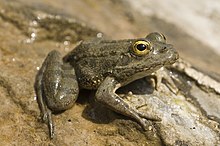Karpathos frog
| Karpathos frog | |
|---|---|

| |
| Pelophylax cerigensis | |
| Scientific classification | |
| Kingdom: | Animalia |
| Phylum: | Chordata |
| Class: | Amphibia |
| Order: | Anura |
| Family: | Ranidae |
| Genus: | Pelophylax |
| Species: | P. cerigensis
|
| Binomial name | |
| Pelophylax cerigensis (Beerli, Hotz, Tunner, Heppich & Uzzell, 1994)
| |
| Synonyms | |
|
Rana cerigensis Beerli, Hotz, Tunner, Heppich & Uzzell, 1994 | |
The Karpathos frog (Pelophylax cerigensis) is a species of frog in the family Ranidae. It is endemic to the island of Karpathos, South Aegean Sea, Greece. The Karpathos frog is considered the most endangered anuran amphibian in Europe because its range is restricted to two small rivers in the north part of the island.[2]
Its natural habitats are Mediterranean-type shrubby vegetation, rivers, intermittent rivers, freshwater lakes, intermittent freshwater lakes, freshwater marshes, intermittent freshwater marshes, arable land and ponds. It is threatened by habitat loss.
References[]
- ^ IUCN SSC Amphibian Specialist Group (2020). "Pelophylax cerigensis". IUCN Red List of Threatened Species. 2020: e.T58567A89696593. doi:10.2305/IUCN.UK.2020-3.RLTS.T58567A89696593.en. Retrieved 17 November 2021.
- ^ National and Kapodistrian Univ. of Athens; Pafilis, P.; Kapsalas, G.; Lymberakis, P.; Protopappas, D.; Sotiropoulos, K. (2019-06-01). "Diet composition of the Karpathos marsh frog (Pelophylax cerigensis): what does the most endangered frog in Europe eat?". Animal Biodiversity and Conservation. 42 (1): 1–8. doi:10.32800/abc.2018.42.0001.
Sources[]
- Pafilis, P., Kapsalas, G., Lymberakis, P., Protopappas, D., & Sotiropoulos, K. (2018). Diet composition of the Karpathos marsh frog (Pelophylax cerigensis): what does the most endangered frog in Europe eat? Animal Biodiversity and Coservation, 42(1), 1–8. doi: 10.32800/abc.2018.42.0001
- Beerli, P. & Uzzell, T. 2004. Rana cerigensis. 2006 IUCN Red List of Threatened Species. Downloaded on 23 July 2007.
Categories:
- IUCN Red List critically endangered species
- Amphibians of Europe
- Pelophylax
- Endemic fauna of Greece
- Amphibians described in 1994
- Dodecanese
- True frog stubs
